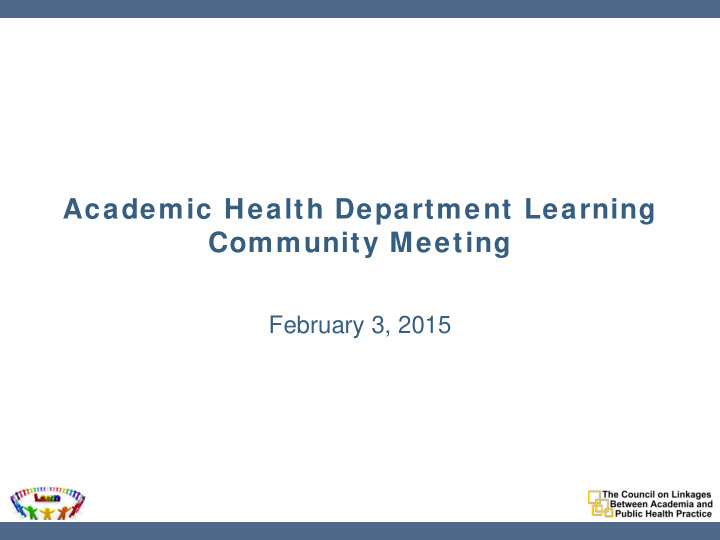



Academic Health Department Learning Community Meeting February 3, 2015
Housekeeping Items Please mute your phone/microphone when you are not speaking. Please mute your computer speakers if you are using your phone. Links to download the presentation slides and the PHAB Accreditation one- pager can be found in the Files box. The meeting will be recorded, and the archive will be available following the meeting. Please use the Chat box to comment or ask questions at any point during the meeting. Once the presentation ends, you will also be able to unmute your phone/microphone to join the discussion.
Today’s Speaker • Jessica Kronstadt, MPP • Director of Research and Evaluation • Public Health Accreditation Board
Accreditation & Academic Health Departments Jessica Kronstadt | February 3, 2015
Introduction to PHAB
PHAB’s Goal The goal of national public health department accreditation is to improve and protect the health of the public by advancing the quality and performance of Tribal, state, local, and territorial public health departments.
What is Public Health Accreditation ? • Standards • Assessment • Decision • Voluntary • QI throughout
The Public Health Accreditation Board (PHAB) • Non-profit • Chartered in 2007 • Launched September 2011
Update and Map • 280 health departments in the system • Conducting site visits • Revised Standards released • Developing several e-PHAB modules • Nine applicant cohorts trained • Trained site visitors
Accreditation Process Pre-application 1 Application 2 Document Selection & Submission 3 Site Visit 4 Accreditation Decision 5 Reports 6 7 Reaccreditation 10
Prerequisites • Community Health Assessment • Community Health Improvement Plan • Strategic Plan • Quality Improvement Plan Image Courtesy of Miles, FreeDigitalPhotos.net 11
Standards & Measures Version 1.5 • 12 Domains • 10 Essential Public Health Services • Management and Administration (Domain 11) • Governing Entity (Domain 12) • “Purpose” and “Significance” for Measures • Required Documentation • Documentation Guidance • http://www.phaboard.org/wp-content/uploads/SM- Version-1.5-Board-adopted-FINAL-01-24- 2014.docx.pdf 12
Added/Expanded Topics in Version 1.5 • Health Equity • Public Health Communications • Public Health Informatics • Public Health Workforce Development • Emergency Preparedness • Public Health Ethics 13
Partnership Opportunities
Partnership Opportunities • Conformity with the Standards – Workforce – Research – Community Health Assessment / Community Health Improvement Plan – Assess Health Care Capacity / Access – Other • Research and Evaluation 15
Workforce • Standard 8.1: Encourage the development of a sufficient number of qualified public health workers – Measure 8.1.1: Relationship and collaboration with educational programs that promote the development of future public health workers • Standard 8.2: Ensure a competent workforce through the assessment of staff competencies, the provision of individual training and professional development, and the provision of a supportive work environment – Workforce development plan/strategies – Recruitment of individuals who reflect the population served – Professional and career development for all staff • Example: Summer program in urban core 16
Research Standards • Standard 10.1: Identify and use the best available evidence for making informed public health practice decisions – Measure 10.1.1 Applicable evidence-based and/or promising practices identified and used when implementing new or revised processes, programs, and/or interventions – Measure 10.1.2 T/S: Fostered innovation in practice and research • Standard 10.2: Promote understanding and use of the current body of research results, evaluations, and evidence-based practices with appropriate audiences – Measure 10.2.2 A: Access to expertise to analyze current research and its public health implications – Measure 10.2.4 S/T: Consultation or technical assistance provided to Tribal and local health departments and other public health system partners in applying relevant research results, evidence-based and/or promising practices • Examples: jointly written studies, participation in practice-based research network 17
CHA/CHIP • Standard 1.1: Participate in or lead a collaborative process resulting in a comprehensive community health assessment • Standard 5.2: Conduct a comprehensive planning process resulting in a Tribal/state/community health improvement plan • NACCHO demonstration project* – Students helped with data collection, analysis, presentation, under supervision of faculty members – Academic partner as subject matter expert – Lessons learned: • Most effective when part of a course on CHA/CHIP • Formal agreements between schools and HDs beneficial *Chudgar R et al. Local health department and academic institution linkages for community health assessment and improvement processes: a national overview and local case study. J Public Health Manag and Pract . 2014;20(3):349–355. 18
Health Care • Standard 7.1: Assess health care service capacity and access to health care services • Measure 7.1.1: Process to assess the availability of health care services • Measure 7.1.2: Identification of populations who experience barriers to health care services • Measure 7.1.3: Identification of gaps in access to health care services and barriers to the receipt of health care services 19
Technical Assistance • 1.4.3 S: Development and use of summaries of community data • 4.1.2 S/T/L: Methods for engaging with the community • 8.2.5 S: Workforce development, training, and continuing education • 9.1.6 S: Performance management 20
Other Standards & Measures • Measure 6.1.1: Laws reviewed in order to determine the need for revisions • Standard 9.1: Use performance management system to monitor achievement of organizational objectives • Others? 21
Research Agenda • Monitoring the evidence base around the Standards and Measures • Current priorities • What are the barriers and facilitators to seeking and obtaining accreditation? • Do the PHAB standards and the review process capture what is most meaningful for evaluating the performance of health departments? How could they be improved? • What are the best metrics to determine the impact of accreditation? • What are the benefits and outcomes associated with accreditation for the health departments that undergo the process? 22
Recommend
More recommend